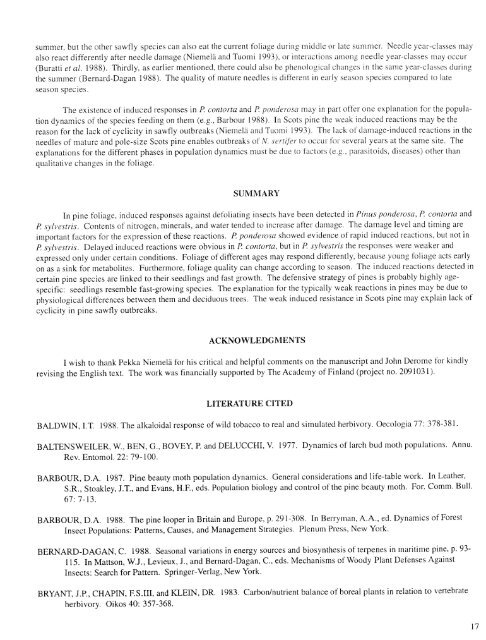View or print this publication - Northern Research Station - USDA ...
View or print this publication - Northern Research Station - USDA ...
View or print this publication - Northern Research Station - USDA ...
Create successful ePaper yourself
Turn your PDF publications into a flip-book with our unique Google optimized e-Paper software.
summer, but the other sawfly species can also eat the current foliage during rniddle <strong>or</strong> late summer. Needle year-classes may<br />
also react differently after needle damage (Niemel_ and Tuomi 1993), <strong>or</strong> interactions among needle year-classes may occur<br />
(Buratti et al. 11988). Thirdly, as earlier rnentioned, there could also be phenological changes in the same year-classes during<br />
the summer (Bernard-Dagan 1988). The quality of mature needles is different m early season species compared to late<br />
season species.<br />
The existence of induced responses in P. cont<strong>or</strong>ta and R potzderosa may in part ofter one explanation f<strong>or</strong> the population<br />
dynamics of the species feeding on them (e.g., Barbour 1988). In Scots pine the weak induced reactions may be the<br />
reason f<strong>or</strong> the tack of cydicity in sawfly outbreaks (Niemela and Tuomi 1993). The lack of damage-induced reactions in the<br />
needles of mature and pole-size Scots pine enables outbreaks of N. sertifer to occur f<strong>or</strong> several years at the same site. The<br />
explanations f<strong>or</strong> the different phases in population dynamics must be due to fact<strong>or</strong>s (e.g., parasitoids, diseases) other than<br />
qualitative changes in the foliage.<br />
SUMMARY<br />
In pine foliage, induced responses against defoliating insects have been detected in P#zus ponderosa, P. cont<strong>or</strong>ta and<br />
P. syh,estris. Contents of nitrogen, minerals, and water tended to increase after damage. The damage level and timing are<br />
imp<strong>or</strong>tant fact<strong>or</strong>s f<strong>or</strong> the expression of these reactions. P. ponderosa showed evidence of rapid induced reactions, but not in<br />
E sylvestris. Delayed induced reactions were obvious in P. cotzt<strong>or</strong>ta, but in P. sylvestris the responses were weaker and<br />
expressed only under certain conditions. Foliage of different ages may respond differently, because young foliage acts early<br />
on as a sink f<strong>or</strong> metabolites. Furtherm<strong>or</strong>e, foliage quality can change acc<strong>or</strong>ding to season. The induced reactions detected in<br />
certain pine species are linked to their seedlings and fast growth. The defensive strategy of pines is probably highly agespecific:<br />
seedlings resemble fast-growing species. The explanation fbr the typically weak reactions in pines may be due to<br />
physiological differences between them and deciduous trees. The weak induced resistance in Scots pine may explain lack of<br />
cyclicity in pine sawfly outbreaks.<br />
ACKNOWLEDGMENTS<br />
I wish to thank Pekka Niemel_i _br his critical and helpful comments on the manuscript and John Derome f<strong>or</strong> kindly<br />
revising the English text. The w<strong>or</strong>k was financially supp<strong>or</strong>ted by The Academy of Finland (project no. 209103 1).<br />
LITERATURE CITED<br />
BALDWIN, I.T. 1988. The alkaloidal response of wild tobacco to real and simulated herbiv<strong>or</strong>y. Oecologia 77: 378-381.<br />
BALTENSWEILER, W., BEN, G., BOVEY, R and DELUCCHI, V. 1977. Dynamics of larch bud moth populations. Annu.<br />
Rev. Entomol. 22: 79-100.<br />
BARBOUR, D.A. 1987. Pine beauty moth population dynamics. General considerations and life-table w<strong>or</strong>k. In Leather,<br />
S.R., Stoakley, J.T., and Evans, H.E, eds. Population biology and control of the pine beauty moth. F<strong>or</strong>. Comm. Bull.<br />
67: 7-13.<br />
BARBOUR, D.A. 1988. The pine looper in Britain and Europe, p. 291-308. In Berryman, A.A., ed. Dynamics of F<strong>or</strong>est<br />
Insect Populations: Patterns, Causes, and Management Strategies. Plenum Press, New Y<strong>or</strong>k.<br />
BERNARD-DAGAN, C. 1988. Seasonal variations in energy sources and biosynthesis of terpenes in maritime pine, p. 93-<br />
115. In Mattson, W.J., Levieux, J., and Bernard-Dagan, C., eds. Mechanisms of Woody Plant Defenses Against<br />
Insects: Search f<strong>or</strong> Pattern. Springer-Verlag, New Y<strong>or</strong>k.<br />
BRYANT, J.R, CHAPIN, F.S.III, and KLEIN, DR. 1983. Carbon/nutrient balance of b<strong>or</strong>eal plants in relation to vertebrate<br />
herbiv<strong>or</strong>y. Oikos 40: 357-368.<br />
17
















